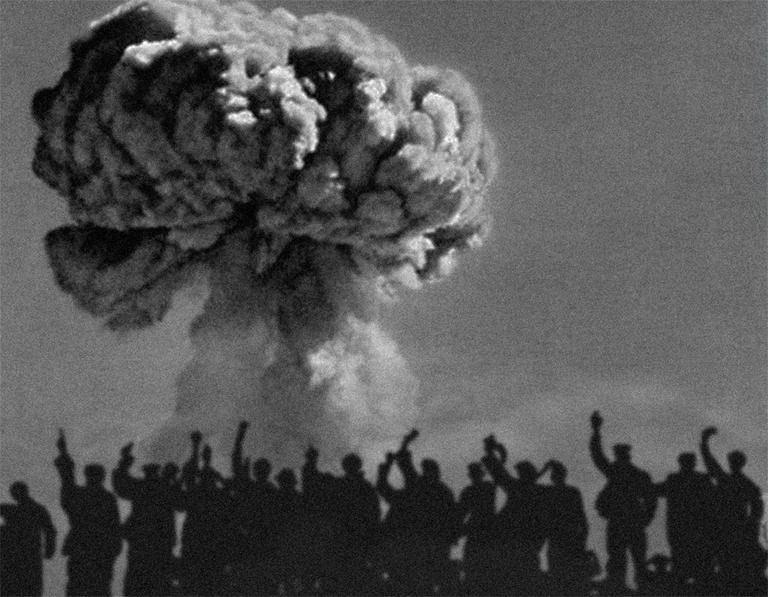This Week in China’s History: October 16, 1964
The attention of China’s leadership was on Miss Qiu, seated at her dressing table, waiting for her braid to be completed. That her “dressing table” was located in the Xinjiang desert, many miles from regular human settlement, was unusual, as was the extraordinary secrecy surrounding the cosmetic ritual. Stakes were high: if anything went wrong with the braid, it would be an expensive national embarrassment.
The braid worked as planned though, and at 3 p.m. China time, Miss Qiu exploded in a blinding flash of light, followed by a mushroom cloud rising into the skies of eastern Xinjiang.
Needless to say, “Miss Qiu” was not a person. It was the code name of China’s first atomic bomb. Atop a 102-meter tower (the “dressing table”), it was triggered by a “braid” (the detonator) on October 16, 1964.
The eyes of the world have frequently been on Xinjiang lately, as reports, and denials, of atrocities against Uyghurs and other Muslims in the region have cast a shadow over China’s foreign relations. This week, we look back to another moment when the actions of the Chinese state in Xinjiang captured global attention, when the People’s Republic became the fifth (and last officially recognized) state to possess nuclear weapons.

Máo Zédōng 毛泽东 announced China’s nuclear ambitions in 1955. In particular, the threat of nuclear weapons during the Taiwan Straits crisis of 1954-55 was critical to convincing Mao that without atomic weapons, China would be unable to maintain its own security. China approached the Soviet Union for help.
The main source in English for what happened next is John Wilson Lewis and Xue Litai’’s 1988 China Builds the Bomb, but Taylor Fravel’s 2019 Active Defense provides additional and updated detail. Together, the two books give a comprehensive picture of the intersection of politics, science, and strategy in a country that was struggling to find its identity.
China’s nuclear program started at the height of Sino-Soviet cooperation. A comprehensive agreement between the two states, signed in 1957 (on October 15), promised a wide range of cooperation, including — at least in Mao’s understanding — the pledge of a prototype nuclear warhead and detailed plans for how to manufacture one. Soviet cooperation on all aspects of the program, from uranium enrichment to weapon design to prospecting, followed in rapid succession.
But the collaboration broke down as relations between China and the Soviet Union did the same. Nikita Khrushchev viewed Mao suspiciously, and felt that China’s actions in conflicts with India and Taiwan, among others, had been provocative and reckless. At the same time, Khrushchev focused increasingly on domestic concerns (and his own political future) as well as presenting a less hostile posture to the West. In June 1959, Khrushchev formally cancelled Soviet aid to China’s nuclear program. Furious, China rededicated itself to developing its own bomb, and renamed the project “596”: June 1959.
Khrushchev’s decision did not catch Chinese planners completely unprepared. Even while the two countries worked together, China ramped up a parallel program to develop nuclear weapons in case Soviet aid was withdrawn. That program kicked into high gear after 1959. The Lop Nur testing site was completed in the fall, even as Khrushchev was denouncing China’s border clashes with India as “stupid” and “sad.”
Still, China’s nuclear planners faced immense challenges. Some were technical, as partially assembled or hastily scuttled Soviet equipment was evaluated for usefulness. Teams of Chinese reassembled, literally, shredded Soviet documents for clues about the process. In particular, a uranium enrichment plant at Lanzhou was unfinished when the Soviets pulled out, and it would be essential for developing weapons.
Challenges were not always technical, and not always external. The withdrawal of Soviet aid coincided with the disastrous Great Leap Forward that threw much of China into famine and chaos. The decision to devote enormous resources to high-technology weapons while tens of millions of people starved illustrated both single-minded focus on a national objective and callous disregard for the people’s wellbeing.
Given the obstacles, the speed with which the bomb was developed surprised observers. Documents now in the National Security Archive at George Washington University reveal that American, Soviet, and Taiwanese analysts reacted with alarm as it became clear that nuclear capability was within reach. In language that foreshadows debates in today’s world surrounding Iran and North Korea, the government in Taiwan urged the United States to take action against Chinese nuclear sites to prevent the development of atomic weapons. As late as April 1964 (just six months before the test), Taiwan’s leaders were urging U.S. airstrikes to eliminate Beijing’s nuclear program.
Once the test was completed, China quickly announced it to the world in a statement:
China exploded an atom bomb at 1500 hours [China Time] on Oct. 16, 1964, and thereby conducted successfully its first nuclear test.
This is a major achievement of the Chinese people in their struggle to increase their national defense capability and oppose the United States imperialist policy of nuclear blackmail and nuclear threats.
The Chinese government also reiterated its proposal — first made a year earlier when the U.S., USSR, and Great Britain had signed a limited nuclear test-ban treaty — that all nuclear powers (itself now included) pledge to destroy their atomic weapons.
In the aftermath of the test — followed within a few years by Chinese tests of ballistic missiles and hydrogen bombs — policymakers scrambled to evaluate the new strategic terrain. Although Mao coined his famous description of the atomic bomb as “a paper tiger” for American weapons, in the 1960s and 1970s, China’s nuclear strategy was aimed as much at the Soviets as the Americans. In both cases, however, China seems to have achieved its major goal of deterrence.
In his book, Fravel identifies China’s nuclear strategy as an odd outlier, for while conventional military strategy in China has evolved over time, its nuclear strategy has changed little since 1964. “Because nuclear strategy was never delegated to the [People’s Liberation Army],” Fravel writes, nuclear strategy was largely determined by “the views about nuclear weapons held by China’s top party leaders. Because these leaders viewed the utility of nuclear weapons as limited to deterring nuclear coercion or attacks, nuclear strategy was not integrated with conventional military strategy and has remained focused on achieving assured retaliation.”
Two legacies of China’s nuclear program sit at the margins of today’s headlines, and so are worth mentioning. The first is that the ongoing and at the moment intensifying rhetorical war over the fate of Taiwan keeps the specter of real war constantly under discussion. Without question, the fact that both the United States and China possess nuclear capability casts this conflict in grave undertones (though some can argue that nuclear deterrence has achieved exactly its goal and prevented open war).
The second is that the testing site itself, in Xinjiang, has had profound and long-lasting effects. Enver Tohti, a Uyghur doctor, and Japanese physicist Jun Takada have established a Lop Nur project, in Sapporo, Japan, to document the health effects of the Xinjiang tests. Interviewed for Scientific American by Zeeya Marali, Takada suggests that as many as 200,000 people in Xinjiang may have died because of the tests carried out there, and that the peak radiation doses in Xinjiang exceeded those on the roof of the Chernobyl reactor during the meltdown (chilling comparisons for anyone who has seen the recent HBO miniseries). Tohti, who described a week when it “rained dust” of nuclear fallout, has estimated that cancer rates in Xinjiang are 30-35% higher than the PRC’s national average.
China’s last nuclear test was conducted in 1996, a few months before the Comprehensive Nuclear Test Ban Treaty was opened for signatures.
This Week in China’s History is a weekly column.






